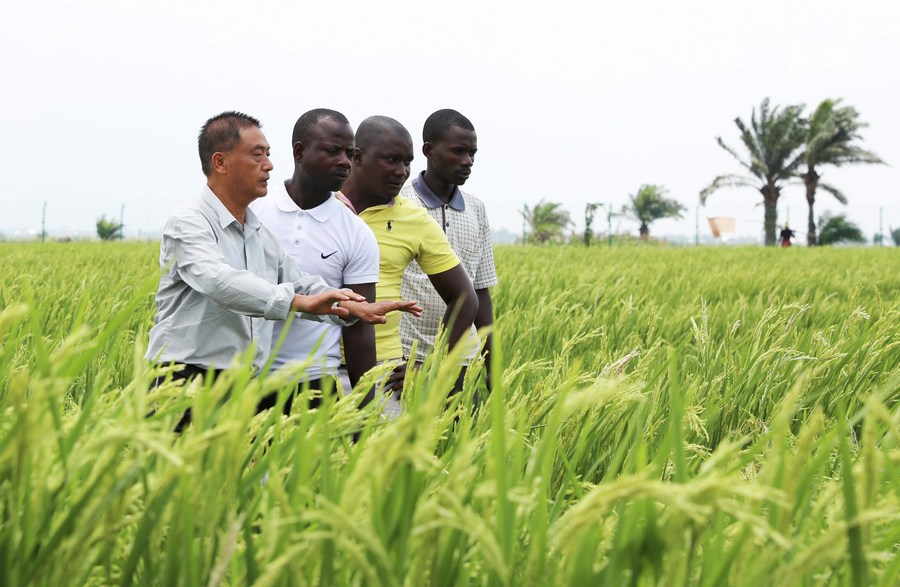


Chinese rice expert Dan Songbai (1st L) instructs farmers in a hybrid rice field in Kihanga, Bubanza Province, Burundi, Oct. 29, 2022. (Xinhua/Dong Jianghui)
The vision of a "China-Africa Community with a Shared Future" provides a dynamic framework to address some of the most pressing challenges facing Tanzania’s agricultural sector. These include low productivity, significant postharvest losses, and limited access to high-value markets. China has become a key partner for Tanzania in its quest for agricultural modernization, particularly through collaborative initiatives such as the Forum on China-Africa Cooperation (FOCAC), the Belt and Road Initiative (BRI), and the China-Africa Think Tanks Forum (CATTF). However, despite notable progress, challenges persist in fully leveraging these collaborations. The path forward will require enhanced local adaptation of technologies, improvements in infrastructure, and more equitable trade frameworks that can benefit both nations.
Technology transfer: Bridging the gap
Agriculture is central to Tanzania’s economy, employing over 65% of the population and contributing about 25% to its GDP. However, structural inefficiencies such as low mechanization, inefficient irrigation, and high postharvest losses hinder its growth. Through the establishment of Agricultural Technology Demonstration Centers (ATDCs), China has introduced innovations such as hybrid rice, mechanization tools, and solar-powered irrigation systems, which have contributed to productivity increases of up to 30%. These technological innovations are seen as key drivers in modernizing Tanzania’s agricultural sector and improving food security.
Nonetheless, while these technologies have the potential to significantly improve productivity, their adoption in Tanzania has been slow and uneven. Smallholder farmers, who dominate the sector, face financial constraints, lack access to adequate infrastructure, and encounter challenges in adapting new technologies to local conditions. This is a critical barrier to achieving the long-term sustainability of these innovations.
To ensure more inclusive and equitable technology transfer, it is crucial to focus on co-developing technologies that are tailored to Tanzania’s specific socio-economic and environmental context. This would involve greater collaboration between Chinese experts and Tanzanian agricultural institutions to adapt technologies to local realities. Furthermore, establishing financing models such as co-financed subsidy programs or micro-credit systems could help overcome the financial barriers that many small holder farmers face.
Reducing postharvest losses: A collaborative approach
Postharvest losses in Tanzania are a major challenge, exceeding 30% annually, largely due to inadequate storage facilities and inefficient cold chain logistics. This has profound implications for food security and the country’s economic development. Collaborative technologies introduced through China-Tanzania partnerships, such as hermetic storage bags and solar-powered cold storage systems, have shown considerable promise in reducing these losses. Studies indicate that hermetic storage bags can reduce grain losses by up to 30%, while solar-powered cold storage systems can extend the shelf life of perishable crops, improving food availability and market access.
These postharvest technologies highlight the tangible benefits of China-Tanzania cooperation. However, despite their potential, the widespread adoption of these technologies remains limited. One major hurdle is the financial inaccessibility of these solutions. Many of the technologies, such as cold storage systems, require significant upfront investment, which is often beyond the reach of smallholder farmers.
To address this, more investment in rural infrastructure is needed, particularly in cold chain logistics, transportation networks, and rural electrification. Public-private partnerships (PPPs) could play a pivotal role in financing these initiatives, making them more scalable and affordable for farmers. This would not only reduce postharvest losses but also strengthen Tanzania’s agricultural supply chains, benefiting both local farmers and international partners, including China.
Expanding market access: From raw exports to value-added products
The trade relationship between China and Tanzania holds immense potential for mutual benefit, yet it remains constrained by structural imbalances. Tanzania's exports to China are dominated by raw commodities, limiting the economic value gained from trade. Expanding into value-added products such as processed cashews or roasted coffee represents a critical opportunity for advancing both nations' shared goals. For Tanzania, it would mean higher export revenues and job creation, while for China, it ensures access to high-quality agricultural products that meet its growing consumer demand.
Collaborative frameworks such as FOCAC, BRI, and CATTF have laid the foundation for improving Tanzania-China trade relations by enhancing infrastructure and reducing trade barriers. However, non-tariff barriers, such as stringent quality standards and certification requirements, continue to pose challenges for Tanzanian exporters. Smallholder farmers and cooperatives often lack the capacity to meet these standards, which limits their ability to access Chinese markets.
To address these barriers, Tanzania must invest in agro-processing industries to transition from being a raw commodity exporter to a producer of value-added agricultural products. Establishing local processing plants for cashews, coffee, and other agricultural products would allow Tanzania to capture more value from its exports. Additionally, simplifying quality certification processes and offering capacity-building programs for smallholder farmers would enable them to meet export standards more effectively.
Strengthening Collaboration for a Shared Future
The collaboration between China and Tanzania in the agricultural sector is a prime example of the potential benefits of South-South cooperation. However, there are still significant gaps that need to be addressed to ensure these partnerships reach their full potential. The socio-economic impacts of Chinese technology transfer, particularly on marginalized groups like women and youth, are still underexplored. Furthermore, scalable financing models to help smallholder farmers adopt advanced agricultural technologies are not yet widely available.
To maximize the benefits of this collaboration, China and Tanzania must prioritize joint efforts in technology development, rural infrastructure, trade equity, and financing models. Strengthening farmer cooperatives could also enhance the collective bargaining power of smallholder farmers, enabling them to access better markets and reduce production costs.
Ultimately, Tanzania’s agricultural modernization must be aligned with both its Vision 2050 and global Sustainable Development Goals (SDGs), particularly SDG 1 (No Poverty) and SDG 2 (Zero Hunger). The partnership with China offers a unique opportunity to address these challenges, foster mutual development, and enhance Tanzania’s integration into global value chains. By addressing the existing gaps and fostering greater equity in trade and technology transfer, both China and Tanzania can move closer to realizing the vision of a "China-Africa Community with a Shared Future."
Contributed by Dr. Bonamax Mbasa, Senior Lecturer at the Institute of Rural Development Planning- Lake Zone Centre, Mwanza - Tanzania
点击右上角![]() 微信好友
微信好友
 朋友圈
朋友圈

请使用浏览器分享功能进行分享
